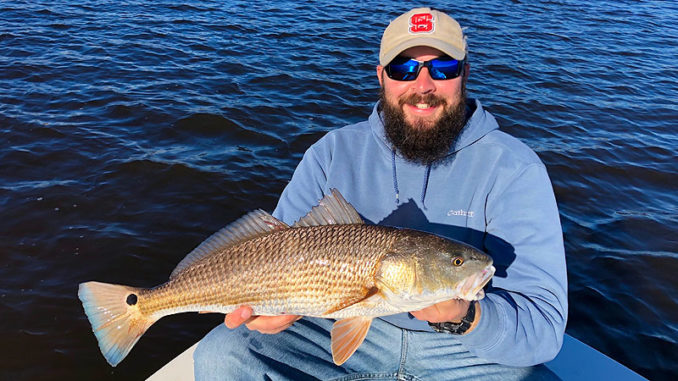
Skittish fish will bite for prepared anglers
March is a month when anglers can get slimed along North Carolina’s central coast, or they can take precautions by fishing with light tackle and may come up clean as a whistle with a decent catch of red drum.
“We get this snotty, green algae that covers the bottom during the spring. (It) breaks up into black strands later in March and makes using the most-effective lures really tough,” said guide David Towler of Swansboro’s Towler Time Charters. “Plus, we’ve had so much pressure on red drum around here, they get spooky when the water temperature’s in the 50s and waters are clear.”
March arrives just as red drum schools begin to break up into smaller groups and head through inlets toward marshes, searching for food. Some fish remain in the ocean, but fishing in ocean rollers is problematic, so Towler mainly sticks to bays, marsh creeks and mud flats.
“You’ll see schools in bays, but they’re usually skittish,” he said. “A lot of people try to get close enough to throw a lure in front of a moving school and let the reds come to the lure, but the commotion a hooked fish makes usually scatters reds. I try to fish school edges so I can move a fish away from schools.”
Red drum are shallow and eating worms
Redfish mostly cruise in extremely shallow water in March, looking for bottom morsels or tiny black crabs that live in oyster rocks.
“Most of them are in water that’s 2 to 3 feet deep; the water’s clear and that helps make them spooky,” said Towler, who uses 7-foot spinning rods, 2000- and 2500-class reels spooled with 10- to 15-pound braid and 18 to 24 inches of fluorocarbon leader.
Towler counts on getting some warm, sunny days this month, with water temperatures starting to climb toward the 60-degree mark.
“Places with mud bottoms hold heat and red drum,” said Towler (910-554-4742), who uses soft-plastic lures such as Z-Man PogyZ or 3-inch Gulp Shrimp rigged on weighted worm hooks. “There’s not a lot of bait in the water, and most of it is small, so little lures work best. There’s also little white worms on the bottom that look like night crawlers. I’ve cleaned drum and found these worms in their bellies.
“Most of the time, I use 1/16-ounce hooks that you can keep off the bottom so the slime won’t foul them.”
If Towler gets two or three warm days in a row, he’ll fish the same lures on a 1/8-ounce worm hook and “dead-stick” them, allowing them to rest motionless on the bottom for 1 to 3 minutes.


